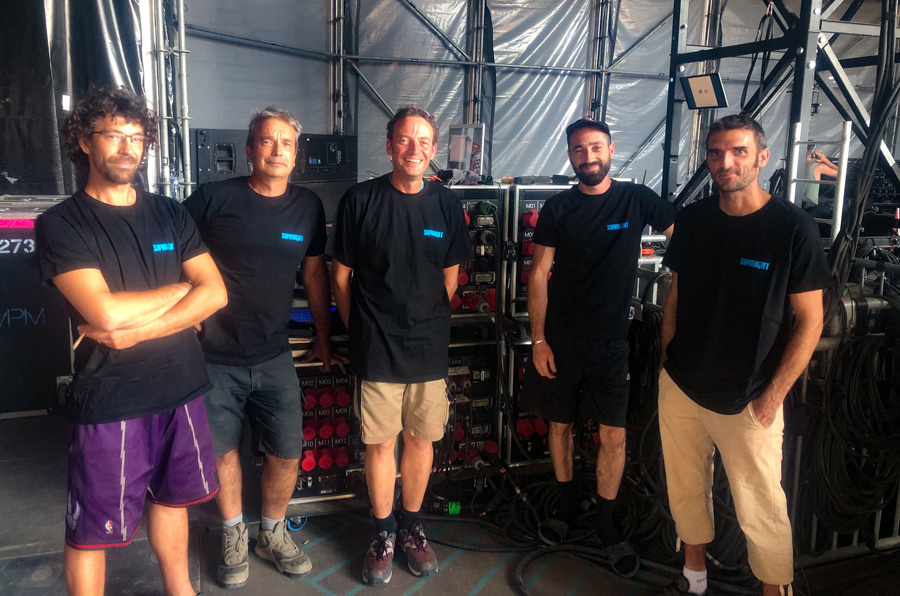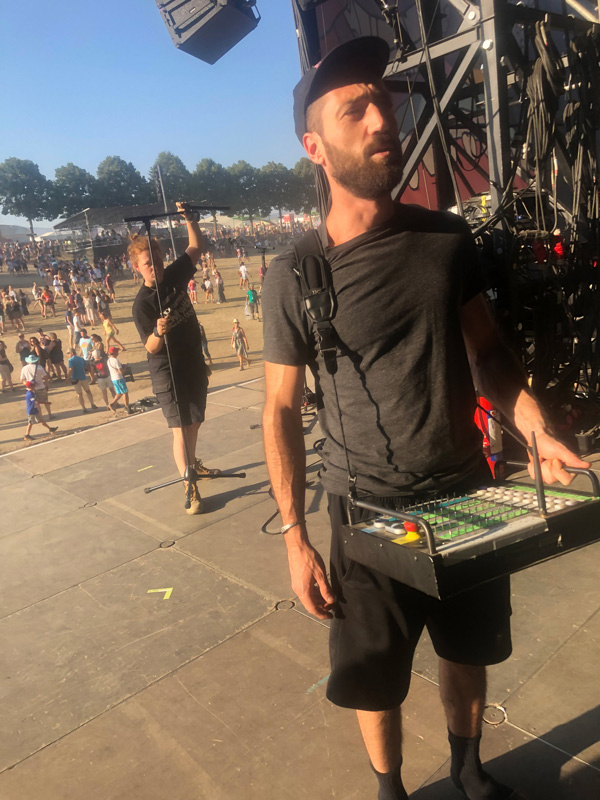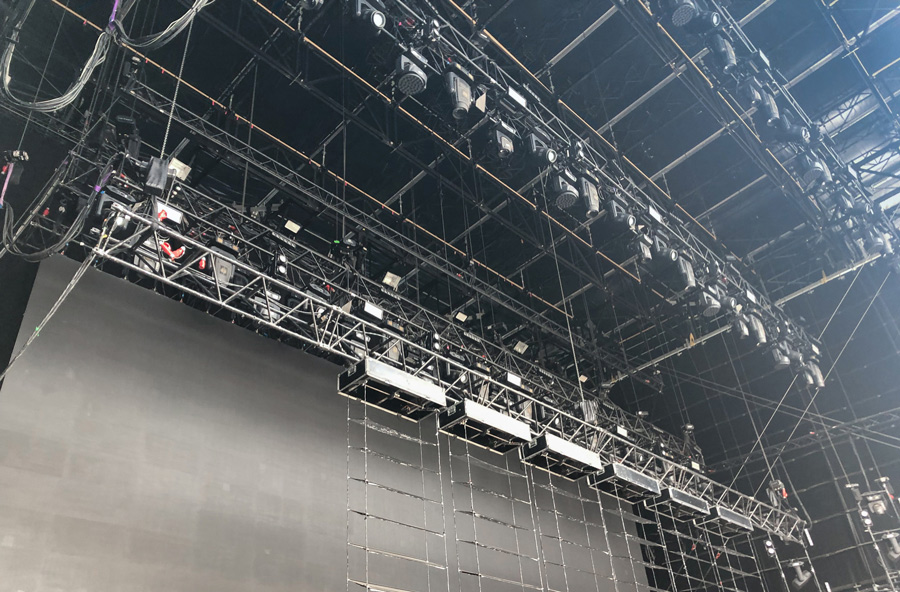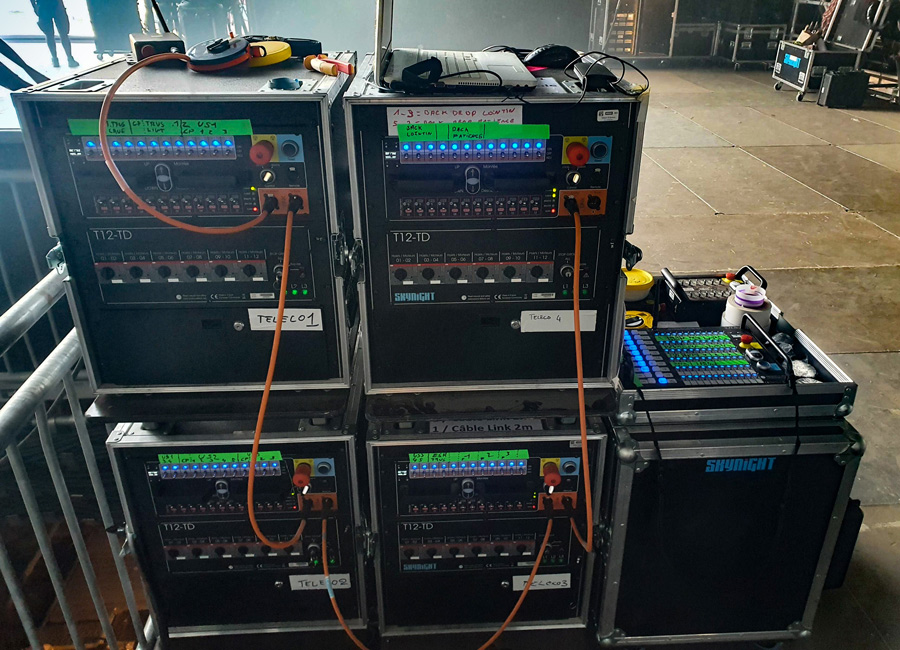Expected since its last edition in 2019, the Paléo Festival, one of the largest open-air festivals in Europe was finally held last July. For this event, Skynight, a Geneva-based company and supplier of rigging equipment for the festival for almost 20 years, partnered with Sonoss for the live test of the “touring” system.
Under the technical direction of “Nick” Sandoz, a team of riggers from the company Seven, including Thomas Rivet and Florian Henning, implemented more than 250 motors on all stages.

Already a user of Sonoss remote controls, Skynight has this year used on the main stage of the festival, the Sonoss remote control with hybrid contactors and memories of groups of 72 channels using HF (wireless, high frequencies). This system is based on racks of 12-way remote controls that can be linked at will.

At the festival, the staff had 5 12-way “touring” remote controls, for a total of 60 channels that could be controlled using HF by the new Sonoss remote control.
Simple to implement, once all the different remote controls are assigned, the mobility that the HF system allows greatly facilitates the entire installation of the rigging kit, avoiding endless round trips to the control module.
The 32 amp In/Out power principle is particularly well suited to this kind of configuration, where rarely more than 12 motors are used together, which makes it possible to be efficient while being energy saving
The ability to create groups simplifies truss movements, also avoiding selection errors.

We interviewed Florian Henning, rigging/lifting expert for the past 5 years for Seven. He configured and operated the HF remote control on the main stage of the Paléo festival. He was present for the duration of the festival as of the set-up.
SLU : We saw this remote control installed permanently at the Grand Palais Ephémère with hybrid contactor cabinets. Is the system also suitable for tours and festivals in terms of ease of setup?
Florian Henning : A kit that has been configured and assembled in “residence” is easy to use on tour. For a festival configuration like the Paléo, in itself, it is not more complicated because the configuration is quite fast.
At the Paléo, on the main stage, I had 56 motors and 6 hybrid contactor remote controls in racks of 12 channels each, and the remote control controlled them entirely using HF.
The motors use conventional P17 plugs that are wired back to the racks and their assignment is simple: the first block on tracks 1 to 12, the second from 13 to 24, and so on. The remote control then recognizes all motors from 1 to 56.

The handling is quite fast and user-friendly knowing that you do not have to configure each motor but only each block of 12 channels. Creating memories of groups of motors is also very simple and reassuring.
When you have your truss 1, for example, rigged to 5 motors + a cable pick, you switch the motors on your remote control (switch lever to ON), their light comes on, you press 3 seconds on one of the 20 group keys, for example, the key 1, and all the motors of this group are assigned to this key. You deselect the engines of the first group memorized and you repeat the operation for the next truss.
When needed, simply deselect the motors (OFF position of the switches), double-click on the group button, and all the lights in the group light up automatically. By pressing the general “ACTION” button up or down, the group’s motors start moving.
When you have to raise a truss, it’s convenient because the motors are all assigned to your group. And if by mistake you trigger another motor, the remote control refuses to start it moving. This is a very important part of its security. This remote control provides real comfort to the job.
You will find below a tutorial by Manuel Lauwerier on how the remote works.
SLU : How does the raising and lowering of trusses work in a festival? Is it once or several times a day?
Florian Henning : In the morning, we put the trusses at the height requested by the technician who is touring with the first entertainer and we do the same operation again between each band. Sometimes the band comes with his video or an add-on kit. For example, the lighting designer of Feu! Chatterton used handmade lights on aluminum foil that tilted.
We had reserved an empty entire truss for his own kit by creating a new group of engines for this truss, marked with gaffer tape. On a festival like Paléo that uses 56 engines, it’s complicated to have everything memorized in your head. And this remote control simplifies the work and allows us to work with more security. That being said, we must always be careful because the main principle of our business is there. This remote control does not prevent you from remaining vigilant and attentive.
SLU : Let’s get back to assigning 12-channel racks. Is it done quickly?
Florian Henning : We had a little bit of trouble because we had never used this remote control and the assignment does not enter into the training of the riggers. But it’s good that it happens, and since I’ve done a lot of electricity and racks in my career, I have notions. That’s why I looked into it when I wasn’t the crew boss of this main stage.
SLU : Are there a lot of bands that have special requests in rigging?
Florian Henning : Each festival will more or less manage to negotiate certain requests, to refuse them when others will accept everything. It really depends on the technical director of the festival. The groups, for the most part, have different height requests, if only for reasons of ambient light, depending on the time of day. At night, for example, they can afford to raise the trusses higher.
Changing the height of the trusses of the in-house kit is a very simple task that does not require sending technicians up in the mother grill (roof and hanging point of a temporary open-air covered stage) and these are requests accepted systematically. These are maneuvers that take no more than 10 to 15 minutes with a technician using the remote control and another who controls visually. On every festival stage we always have two riggers present. However, lowering a truss to replace all of the lighting fixtures on it, is longer obviously.
For example, for Stromae, which had the biggest kit hosted at Paléo, we looked at things differently. When the bands have their touring riggers, we provide remote controls. We hang the motors and trusses and provide them with a remote control. They are the ones who take charge. At Paléo we had decided to reserve the Sonoss remote control for our trusses, in other words, those of the general in-house kit.
For the trusses of the Stromae add-on kit, we had a classic remote control with standard contacts that all riggers are used to, available. And the Stromae riggers only had their hands on the add-on kit. And if there were movements to be made with our trusses, it was up to us to manage them. It was imposed by our insurance company. No one but the Skynight team was qualified to control our motors.
SLU : Are there any negative things concerning this remote control system you would like to mention?
Florian Henning : No, no negative points on the remote control system. It’s really good. The riggers finally have a great product available. I once managed a grill using 40 motors to lift together and until now there was no other remote control capable of doing it with such comfort and safety.
More information on the Sonoss website







